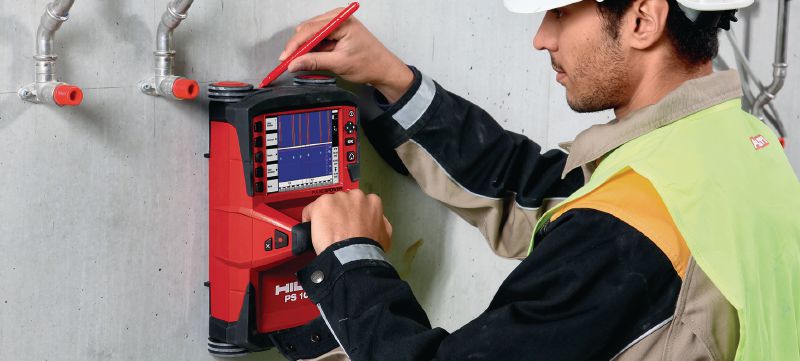Enhanced RainierGPR Concrete Scanning Solutions Revealed
Enhanced RainierGPR Concrete Scanning Solutions Revealed
Blog Article
Harness the Strategic Side of Concrete Scanning for Unparalleled Task Success and Quality Control
In the realm of modern-day building and framework development, the application of concrete scanning modern technology has arised as a pivotal device for making certain project success and maintaining high quality requirements. The true power of concrete scanning lies not just in its capacity to enhance job results yet likewise in its capacity to revolutionize typical techniques, setting a brand-new standard for accuracy and effectiveness in the building industry.
The Significance of Concrete Scanning
Concrete scanning is a crucial action in building and construction tasks to ensure the security and integrity of structures. By utilizing numerous scanning modern technologies such as Ground Passing Through Radar (GPR) and electromagnetic induction, construction teams can non-destructively evaluate the subsurface of concrete frameworks to recognize prospective risks like rebar, avenues, or post-tension wires. This details is vital for job managers, engineers, and service providers to make educated choices and prevent costly blunders during the building and construction procedure.
One of the primary factors why concrete scanning is so crucial is its ability to stop mishaps and injuries on the construction website. Mistakenly reducing through an online electrical channel or damaging post-tension cords can have tragic repercussions, not just in terms of safety yet additionally in regards to job hold-ups and financial effects. By conducting thorough concrete scanning before any type of drilling, cutting, or coring tasks, construction teams can minimize risks and develop a more secure working setting for everybody involved.
Along with security considerations, concrete scanning also plays a key role in making sure the long-lasting resilience and top quality of the framework. By spotting any type of defects or anomalies concealed under the surface area, such as voids or delamination, early intervention can be carried out to attend to these problems prior to they rise into more significant troubles. Ultimately, investing in concrete scanning is a positive procedure that can conserve time, cash, and sources in the future, while also maintaining the highest possible criteria of building and construction quality.
Advanced Modern Technology for Specific Results

By integrating these sophisticated innovations into concrete scanning practices, construction groups can simplify operations, minimize job delays, and guarantee the overall quality and success of the task. The accuracy and effectiveness provided by these tools add considerably to the task's success by assisting in notified developing and decision-making top quality assurance steps.
Enhancing Job Efficiency and Timelines

Additionally, concrete scanning allows teams to identify potential risks and structural weaknesses early on, enabling timely remediation and avoiding accidents that could thwart task timelines. The real-time information supplied by scanning devices assists in notified decision-making, causing smoother sychronisation among different professions and stakeholders. This boosted cooperation decreases problems, enhances efficiency, and ultimately increases task shipment.
Additionally, by proactively resolving concerns via concrete scanning, construction teams can follow schedules better, decrease downtime, and enhance resource appropriation. The capability to discover covert obstacles and validate structural honesty effectively adds to total job performance and timelines, making certain effective outcomes and customer complete satisfaction.
Ensuring Safety and Danger Mitigation

Risk reduction approaches can be improved through the in-depth information given by concrete scanning, allowing task teams to make enlightened decisions that reduce the probability of unexpected occurrences. Additionally, by precisely drawing up subsurface conditions, contractors can prevent costly rework, hold-ups, and damage to existing structures, better adding to total job safety and security and success. Carrying out concrete scanning as a regular method not just makes certain a more click here to read secure workplace yet also infuses confidence in stakeholders relating to the task's commitment to high quality and danger monitoring.
Quality Control Through Concrete Scanning
Concrete scanning plays an essential duty in upholding quality control criteria within construction projects. By using innovative scanning technologies such as Ground Penetrating Radar (GPR) and Concrete X-ray, job managers and engineers can make sure the honesty and high quality of concrete structures. With concrete scanning, prospective issues, such as gaps, splits, or enhancing bar blockage, can be discovered non-destructively, permitting prompt treatments to keep the architectural honesty of the job.
Quality control via concrete scanning not just aids in recognizing existing concerns yet likewise allows positive procedures to stop future issues that might jeopardize the security and durability of the structure. By conducting extensive scans at crucial stages of building, teams can verify the accuracy of structural strategies, validate the placement of vital aspects, and address any deviations promptly. This aggressive strategy lessens rework, minimizes costly hold-ups, and eventually results in the delivery of high-quality, durable frameworks that go beyond or satisfy industry criteria.
Final Thought
In final thought, concrete scanning plays a crucial role in making sure task success, quality, efficiency, and safety assurance. The strategic edge offered by concrete scanning enables for aggressive threat reduction and boosts total task monitoring.
In the world of modern-day building and facilities advancement, the use of concrete scanning innovation has emerged as a critical tool for ensuring project success and keeping top quality criteria. By integrating these sophisticated technologies into concrete scanning techniques, building and construction teams can improve process, minimize project hold-ups, and make certain the general high quality and success of the project.Offered the vital nature of project effectiveness and these details timelines in construction monitoring, the emphasis now shifts in the direction of making sure safety and mitigating threats within the project environment.Concrete scanning plays a pivotal function in supporting quality guarantee standards within building and construction jobs. By making use of sophisticated scanning innovations such as Ground Passing Through Radar (GPR) and Concrete X-ray, task supervisors and engineers can make certain the stability and quality of concrete frameworks.
Report this page